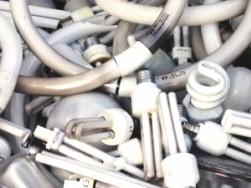Categories: Featured Articles » Sources of light
Number of views: 25252
Comments on the article: 14
Can the use of energy-saving lamps cause an environmental disaster?
 It's no secret that for a long time in every house there is energy saving lampwhich are undoubtedly more economical than conventional incandescent lamps. With all the advantages of energy-saving lamps, they also have a significant drawback - these lamps contain mercury. Vapors of this heavy metal can cause serious poisoning.
It's no secret that for a long time in every house there is energy saving lampwhich are undoubtedly more economical than conventional incandescent lamps. With all the advantages of energy-saving lamps, they also have a significant drawback - these lamps contain mercury. Vapors of this heavy metal can cause serious poisoning.
The problem of recycling and recycling energy-saving lamps unsuitable for use is being actively addressed. There are regulations that clearly regulate the fact that all available energy-saving lamps must be recycled.
Such attention to this type of waste is due to the mercury content sufficient for poisoning (2 - 7 grams), especially indoors. This problem may seem far-fetched, but imagine if you have a lot of such lamps in your home or in a landfill, then it is easy to get severe poisoning. The penetration of mercury into the body occurs by inhaling its odorless vapors, with further damage to the nervous system, liver, kidneys, and gastrointestinal tract.
Mercury easily penetrates into living organisms and integrates into their vital processes. From there they can get to us again. Mercury is assigned the first hazard class. Therefore, it is very important to properly dispose of energy-saving lamps, otherwise an environmental disaster can await us all!
Everyone who has energy-saving lamps at home that have failed, must necessarily take them to specialized reception centers (stationary and mobile). In this case, the lamps should be intact, without cracks. These bulbs need to be stored at home separately from the rest of the garbage and in no case should they be thrown into a common container.
Abroad, there are special containers for the disposal of energy-saving lamps in which hazardous lamps are collected. They are designed specifically for this type of waste. When the container is full, it is transported by special transport and a new one comes in its place.
 We do not have such special waste containers yet, and in order to get rid of a burned out energy-saving lamp, you need to look for a special organization that deals with their disposal. But are all our citizens prepared to do this? Or will the majority throw them along with household waste?
We do not have such special waste containers yet, and in order to get rid of a burned out energy-saving lamp, you need to look for a special organization that deals with their disposal. But are all our citizens prepared to do this? Or will the majority throw them along with household waste?
The problem is also that, according to a number of scientists and critics of the widespread introduction of energy-saving lamps in home lighting in Russia, there are very few organizations that can and can utilize energy-saving lamps in accordance with all the rules and taking into account all requirements.
Specialized facilities should have kits for demercurization in case the lamp containing mercury breaks. When transporting fluorescent lamps, safety precautions should be followed as for the transport of dangerous goods. Transportation should be in specialized containers. These lamps are stored before processing should in special rooms. They should have gas detectors to determine the presence of mercury vapor.
How serious is this problem? Can the presence of mercury in energy-saving lamps, carelessness and punctuality in relation to various instructions (including in relation to the collection of household waste) of most citizens of our country lead to failure from the use of energy-saving lamps?
See also at e.imadeself.com
:
